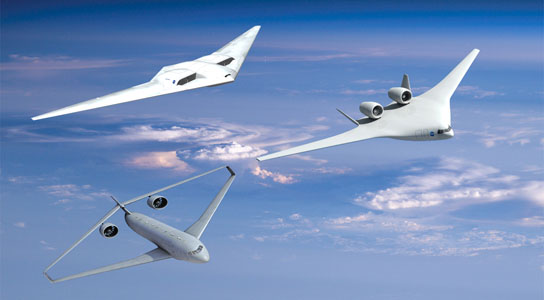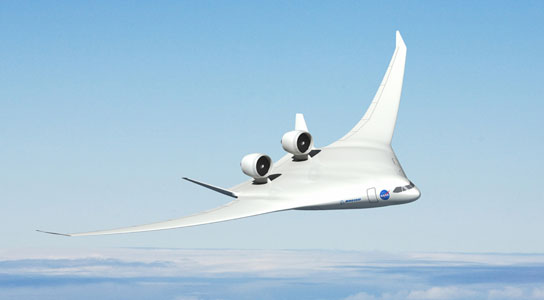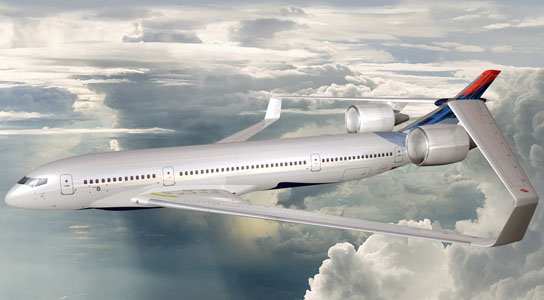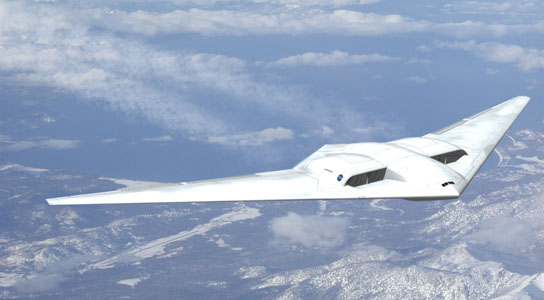
For the past year, leading aircraft manufacturers, Lockheed Martin, The Boeing Company, and Northrop Grumman, have been trying to meet NASA’s challenge and develop green technology that would allow future aircraft to burn 50 percent less fuel than the aircraft that began service in 1998 while emitting 75 percent fewer harmful emissions. The three manufacturers just submitted their results to NASA for review and while the designs vary, all were close to achieving the 50-percent fuel burn reduction.
Leaner, greener flying machines for the year 2025 are on the drawing boards of three industry teams under contract to the NASA Aeronautics Research Mission Directorate’s Environmentally Responsible Aviation Project.
Teams from The Boeing Company in Huntington Beach, California, Lockheed Martin in Palmdale, California, and Northrop Grumman in El Segundo, California, have spent the last year studying how to meet NASA goals to develop technology that would allow future aircraft to burn 50 percent less fuel than aircraft that entered service in 1998 (the baseline for the study), with 75 percent fewer harmful emissions; and to shrink the size of geographic areas affected by objectionable airport noise by 83 percent.
“The real challenge is we want to accomplish all these things simultaneously,” said ERA project manager Fay Collier. “It’s never been done before. We looked at some very difficult metrics and tried to push all those metrics down at the same time.”
So NASA put that challenge to industry – awarding a little less than $11 million to the three teams to assess what kinds of aircraft designs and technologies could help meet the goals. The companies have just given NASA their results.
“We’ll be digesting the three studies and we’ll be looking into what to do next,” said Collier.

Boeing’s advanced vehicle concept centers around the company’s now familiar blended wing body design as seen in the sub-scale remotely piloted X-48, which has been wind tunnel tested at NASA’s Langley Research Center and flown at NASA’s Dryden Flight Research Center. One thing that makes this concept different from current airplanes is the placement of its Pratt & Whitney geared turbofan engines. The engines are on top of the plane’s back end, flanked by two vertical tails to shield people on the ground from engine noise. The aircraft also would feature an advanced lightweight, damage tolerant, composite structure; technologies for reducing airframe noise; advanced flight controls; hybrid laminar flow control, which means surfaces designed to reduce drag; and long-span wings which improve fuel efficiency.

Lockheed Martin took an entirely different approach. Its engineers proposed a box wing design, in which a front wing mounted on the lower belly of the plane is joined at the tips to an aft wing mounted on top of the plane. The company has studied the box wing concept for three decades, but has been waiting for lightweight composite materials, landing gear technologies, hybrid laminar flow and other tools to make it a viable configuration. Lockheed’s proposal combines the unique design with a Rolls Royce Liberty Works Ultra Fan Engine. This engine has a bypass ratio that is approximately five times greater than current engines, pushing the limits of turbofan technology.

Northrop Grumman chose to embrace a little of its company’s history, going back to the 1930s and ’40s, with its advanced vehicle concept. Its design is a flying wing, championed by Northrop founder Jack Northrop, and reminiscent of its B-2 aircraft. Four high-bypass engines, provided by Rolls Royce and embedded in the upper surface of the aerodynamically efficient wing would provide noise shielding. The company’s expertise in building planes without the benefit of a stabilizing tail would be transferred to the commercial airline market. The Northrop proposal also incorporates advanced composite materials and engine and swept wing laminar flow control technologies.
What the studies revealed is that NASA’s goals to reduce fuel consumption, emissions, and noise are indeed challenging. The preliminary designs all met the pollution goal of eliminating landing and takeoff emissions of nitrogen oxides by 50 percent. All still have a little way to go to meet the other two challenges. All the designs were very close to a 50-percent fuel burn reduction, but noise reduction capabilities varied.
“All of the teams have done really great work during this conceptual design study,” says Mark Mangelsdorf, ERA Project chief engineer. “Their results make me excited about how interesting and different the airplanes on the airport ramp could look in 20 years. Another great result of the study is that they have really helped us focus where to invest our research dollars over the next few years,” he said.
NASA’s ERA project officials say they believe all the goals can be met if small gains in noise and fuel consumption reduction can be achieved in addition to those projected in the industry studies. The results shed light on the technology and design hurdles airline manufacturers face in trying to design lean, green flying machines and will help guide NASA’s environmentally responsible aviation investment strategy for the second half of its six-year project.